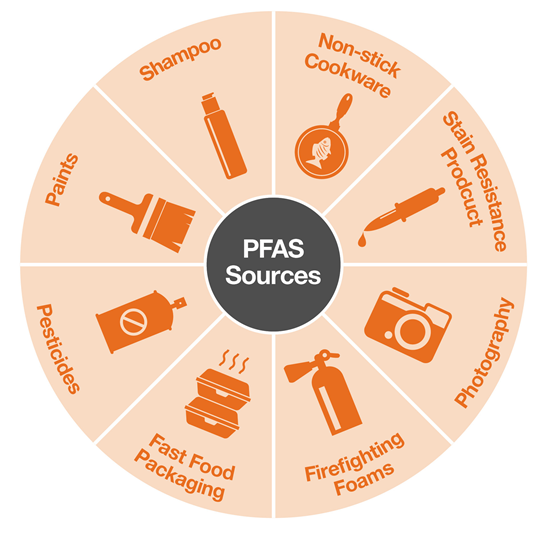
The Environmental Protection Agency (EPA) and scientific communities across the country have renewed their focus on per- and polyfluoroalkyl substances (primarily PFOA and PFOS) collectively known as PFAS. PFAS are a collection of manmade fluorinated organic chemicals that have been utilized and produced in the United States dating back to the 1940s, made popular by their water and oil repellant attributes.
The water repellant properties make them popular for use in textiles (e.g. umbrellas), paper products (e.g. fast food wrappers and pizza boxes), leather, and performance materials such as plastic, waxes, and adhesives. PFAS are also used in class B fluorine-containing firefighting foams for extinguishing flammable liquid fires.
The recent attention surrounding PFAS reportedly has arisen due to a further understanding of the health and environmental impacts related to the disposal and release of PFAS into the environment. According to the Agency for Toxic Substances and Disease Registry (ATSDR), PFAS have, in some cases, been linked to adverse health effects including increased cholesterol levels, interference with the body’s natural hormones, and increased difficulty getting pregnant.
In addition to the popular usage of PFAS in consumer and household products, studies show exposure to PFAS can occur through drinking water contamination, food packaging containing PFAS, storm water runoff, and PFAS-containing wastes, such as the gases omitted from landfills.
In 2009, the EPA established provisional health advisories for PFOA at 400 parts per trillion (ppt) and for PFOS 200 ppt. In 2016, the EPA established lifetime health advisories of 70 ppt for PFOA and PFOS based on the agency’s assessment of the latest peer-reviewed science. In late May, the EPA will host a PFAS National Leadership Summit and Engagement in Washington, D.C. Following the Summit, the EPA will engage more heavily with states impacted by PFAS contamination to find ways the agency can support state, local, and tribal efforts.
The EPA plans to develop a PFAS management plan for release later this year. There are a variety of laws and regulations that the EPA may use to regulate PFAS in the environment including the Safe Drinking Water Act, Toxic Substances Control Act (TSCA), Comprehensive Environmental Response, Compensation and Liability Act and Clean Air Act.
In the interim, several states have proposed or adopted their own standards for PFAS compounds from as low as 14 ppt. Litigation has also increased surrounding PFAS and their role in the contamination of drinking water. In February, Minnesota Attorney General Lori Swanson announced an $850 million settlement from 3M, a multinational company that produces products such as Scotch Tape, Ace bandages, and Post-it Notes. Additionally, Ohio Attorney General Mike DeWine brought suit against DuPont and Chemours Company earlier this year for damages and restitution over the release of PFAS from their plant in West Virginia into the Ohio River.
The EPA and scientific and legal communities have pledged commitment to help address the many challenges with PFAS. Reducing PFAS exposure, continuing to research the health impacts of PFAS, and increased regulatory measures all play a role in the emerging awareness of the substances.




